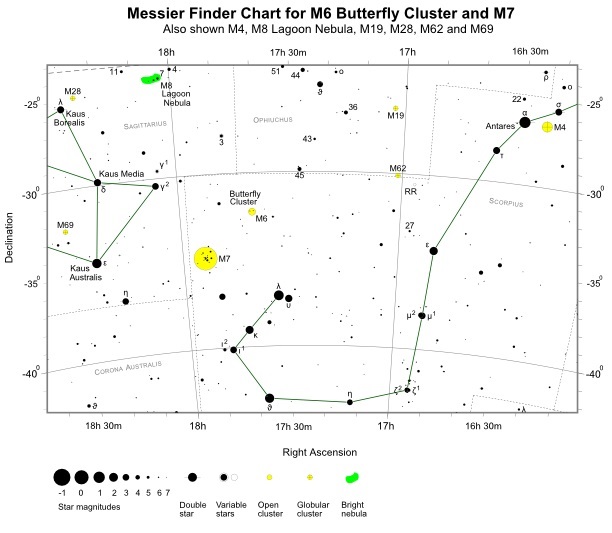M19 is a magnitude +7.2 globular cluster visible with binoculars that's located in the constellation of Ophiuchus. It's an intrinsically large object, which is highly oblate in appearance, loosely packed and partly resolvable using medium sized amateur telescopes. The cluster was discovered on June 5, 1764 by Charles Messier and first resolved into stars by William Herschel in 1784.
Finding M19 is easy as its positioned 8 degrees east of the brightest star in neighbouring Scorpius, Antares (α Sco; mag. +1.0). Located 4.5 degrees south of M19 is a slightly brighter Messier globular, M62 (mag. +6.8).
M19 is best seen from tropical and Southern Hemisphere latitudes during May, June and July. However, for northern temperate based observers it never rises particularly high above the southern horizon.


Finder Chart for M19 - pdf format (credit:- freestarcharts)

When viewed through binoculars, M19 appears stellar like with a hint of fuzziness. A small 80mm (3.1-inch) telescope reveals an obviously diffuse object without a well-defined centre. On nights of good seeing and transparency a 200mm (8-inch) scope, at medium to high magnifications, will resolve the outer edges of M19. The oval shape of the cluster is noticeable, with the long axis orientated in the north-south direction. When viewed through the largest of amateur scopes countless more stars are visible across the face of M19. Visually it spans about 8 to 10 arc minutes of apparent sky.
M19 is located 28,700 light-years from Earth. In total, the cluster has a diameter of 17 arc minutes, which corresponds to an intrinsic diameter of 140 light-years. The brightest individual stars in M19 are of 14th magnitude, although the cluster contains very few variable stars. To date, only four RR Lyrae stars have been discovered.
It's estimated that M19 is 11.9 billion years old.
M19 Data Table
| Messier | 19 |
|---|---|
| NGC | 6273 |
| Object Type | Globular cluster |
| Constellation | Ophiuchus |
| Distance (light-years) | 28,700 |
| Apparent Mag. | +7.2 |
| RA (J2000) | 17h 02m 38s |
| DEC (J2000) | -26d 16m 05s |
| Apparent Size (arc mins) | 17 x 17 |
| Radius (light-years) | 70 |
| Age (years) | 11.9 Billion |
| Number of Stars | 300,000 |